1998 CHEVROLET CAVALIER towing
[x] Cancel search: towingPage 235 of 400
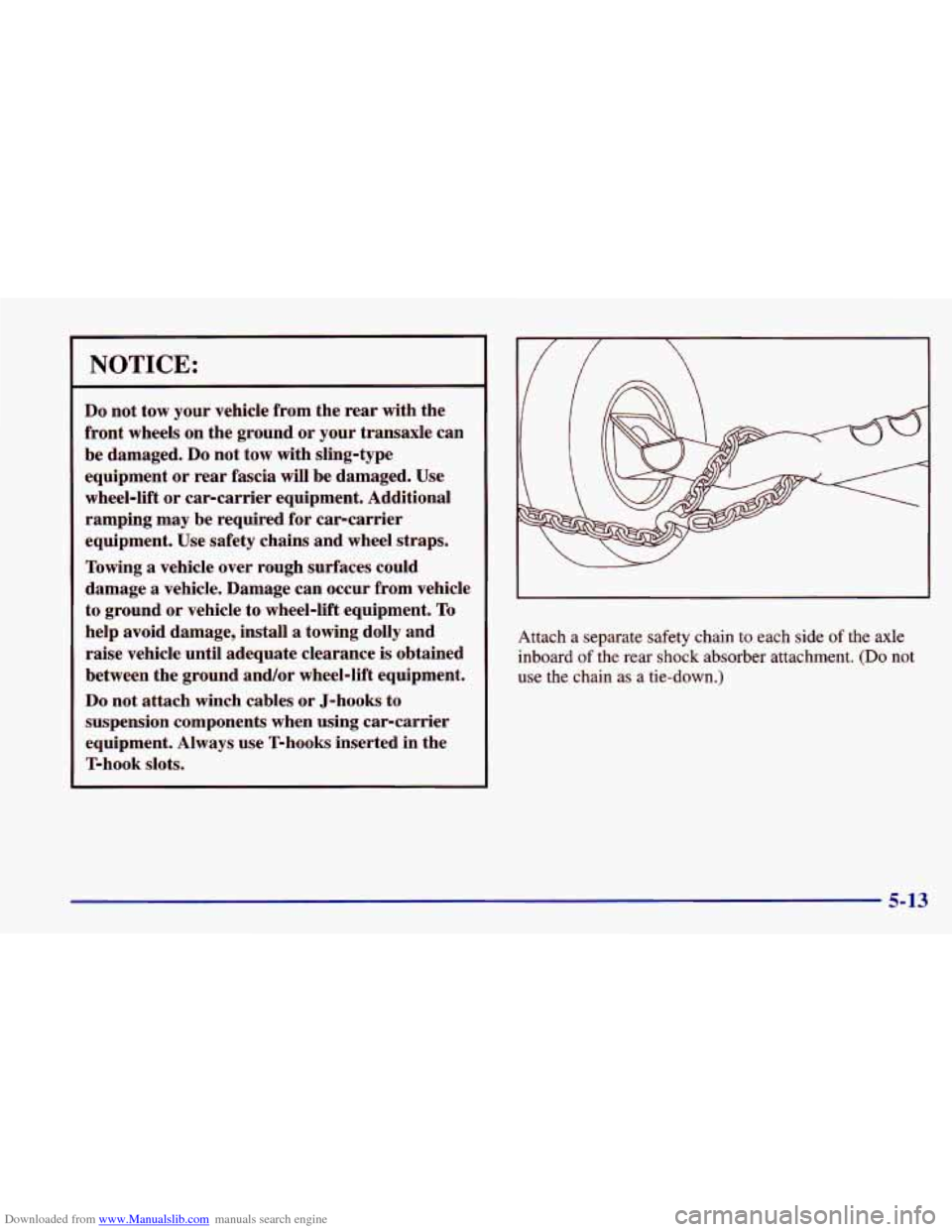
Downloaded from www.Manualslib.com manuals search engine NOTICE:
Do not tow your vehicle from the rear with the
front wheels
on the ground or your transaxle can
be damaged.
Do not tow with sling-type
equipment or rear fascia will be damaged. Use
wheel-lift or car carrier equipment. Additional
ramping may be required for car-carrier
equipment. Use safety chains and wheel straps.
Towing a vehicle over rough surfaces could
damage a vehicle. Damage can occur from vehicle
to ground or vehicle to wheel-lift equipment. To
help avoid damage, install
a towing dolly and
raise vehicle until adequate clearance
is obtained
between the ground and/or wheel-lift equipment.
Do not attach winch cables or J-hooks to
suspension components when using car-carrier
equipment. Always use T-hooks inserted in the
T-hook slots.
Attach a separate safety chain to each side of the axle
inboard
of the rear shock absorber attachment. (Do not
use the chain
as a tie-down.)
5-13
Page 256 of 400
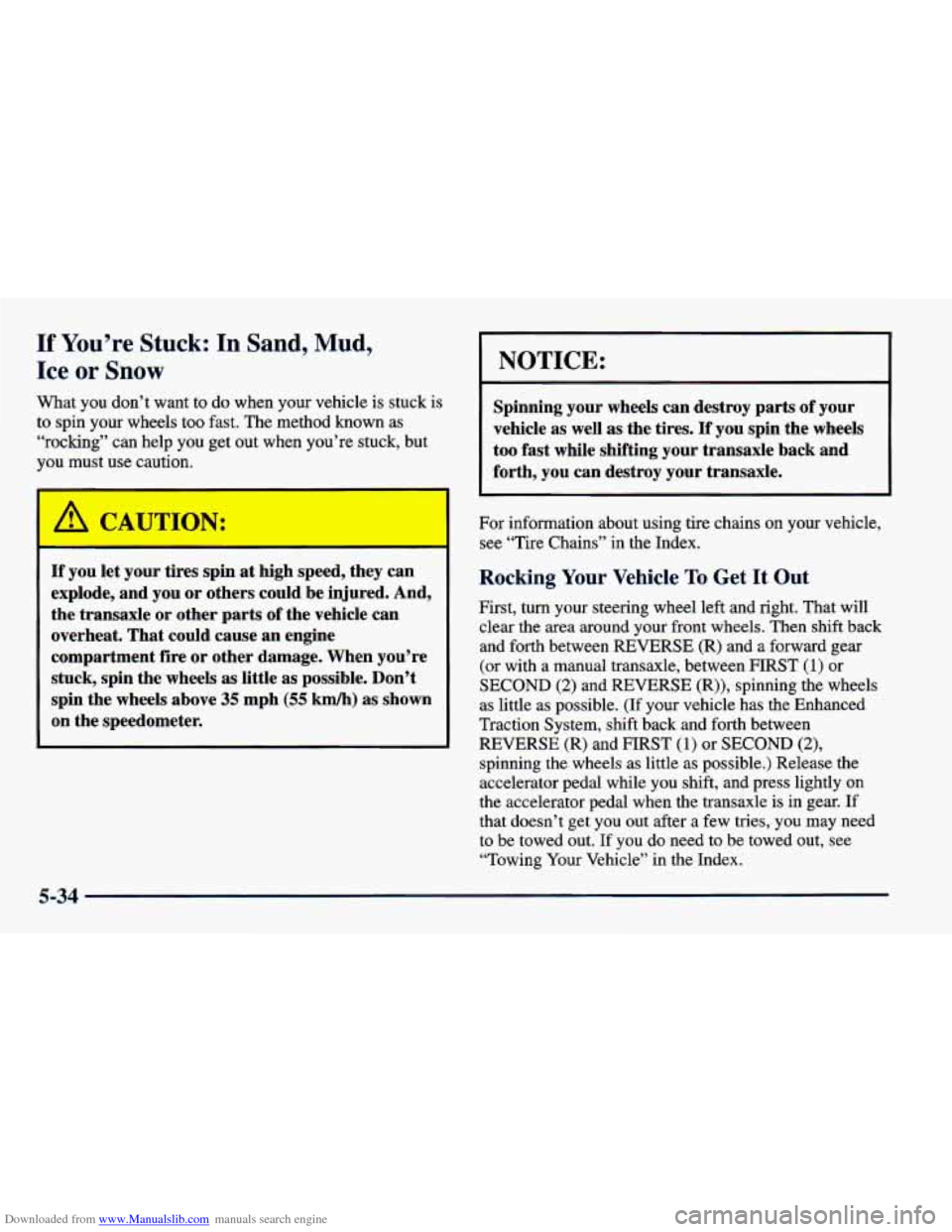
Downloaded from www.Manualslib.com manuals search engine If You’re Stuck: In Sand, Mud,
Ice or Snow
What you don’t want to do when your vehicle is stuck is
to spin your wheels too fast. The method known as
“rocking” can help you get out when you’re stuck, but
you must use caution.
I
NOTICE:
Spinning your wheels can destroy parts of your
vehicle as well
as the tires. If you spin the wheels
too
fast while shifting your transaxle back and
forth, you can destrov vour transaxle.
If you let your tires spin at high speed, they can
explode, and
you or others could be injured. And,
the transaxle
or other parts of the vehicle can
overheat. That could cause an engine
compartment fire
or other damage. When you’re
stuck, spin the wheels as little as possible. Don’t
spin the wheels above
35 mph (55 km/h) as shown
on the speedometer.
For information about using tire chains on your vekfe,
see “Tire Chains” in the Index.
Rocking Your Vehicle To Get It Out
First, turn your steering wheel left and right. That will
clear the area around your front wheels. Then shift back and forth between REVERSE (R) and a forward gear
(or with a manual transaxle, between FIRST
(1) or
SECOND
(2) and REVERSE (R)), spinning the wheels
as little as possible.
(If your vehicle has the Enhanced
Traction System, shift back and forth between
REVERSE (R) and FIRST
(1) or SECOND (2),
spinning the wheels as little as possible.) Release the
accelerator pedal while you shift, and press lightly on
the accelerator pedal when the transaxle is in gear. If that doesn’t get
you out after a few tries, you may need
to be towed out. If you do need to be towed out, see
“Towing Your Vehicle” in the Index.
5-34
Page 276 of 400
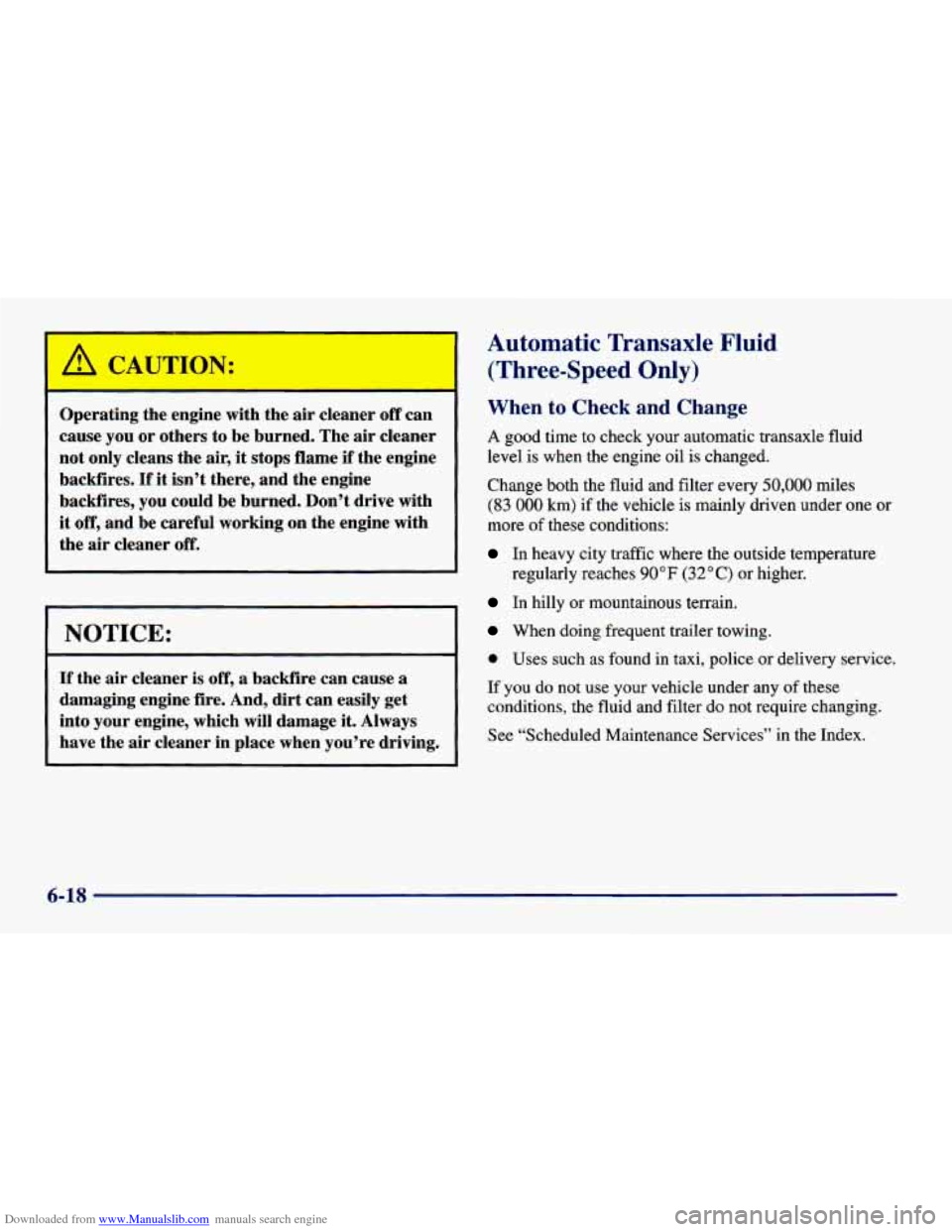
Downloaded from www.Manualslib.com manuals search engine Operating the engine with the air cleaner off can
cause you or others to be burned. The air cleaner
not only cleans the air, it stops flame
if the engine
backfires.
If it isn’t there, and the engine
backfires, you could be burned. Don’t drive with
it
off, and be careful working on the engine with
the air cleaner
off.
NOTICE:
If the air cleaner is off, a backfire can cause a
damaging engine fire. And, dirt can easily get
into your engine, which will damage it.
Always
have the air cleaner in place when you’re driving.
Automatic Transaxle Fluid
(Three-Speed Only)
When to Check and Change
A good time to check your automatic transaxle fluid
level is when the engine oil is changed.
Change both the fluid and filter every
50,000 miles
(83 000 km) if the vehicle is mainly driven under one or
more of these conditions:
In heavy city traffic where the outside temperature
In hilly or mountainous terrain.
When doing frequent trailer towing.
0 Uses such as found in taxi, police or delivery service.
If you do not use your vehicle under any of these
conditions, the fluid and filter do not require changing.
See “Scheduled Maintenance Services’’ in the Index. regularly reaches
90°F (32°C)
or higher.
6-18
Page 279 of 400
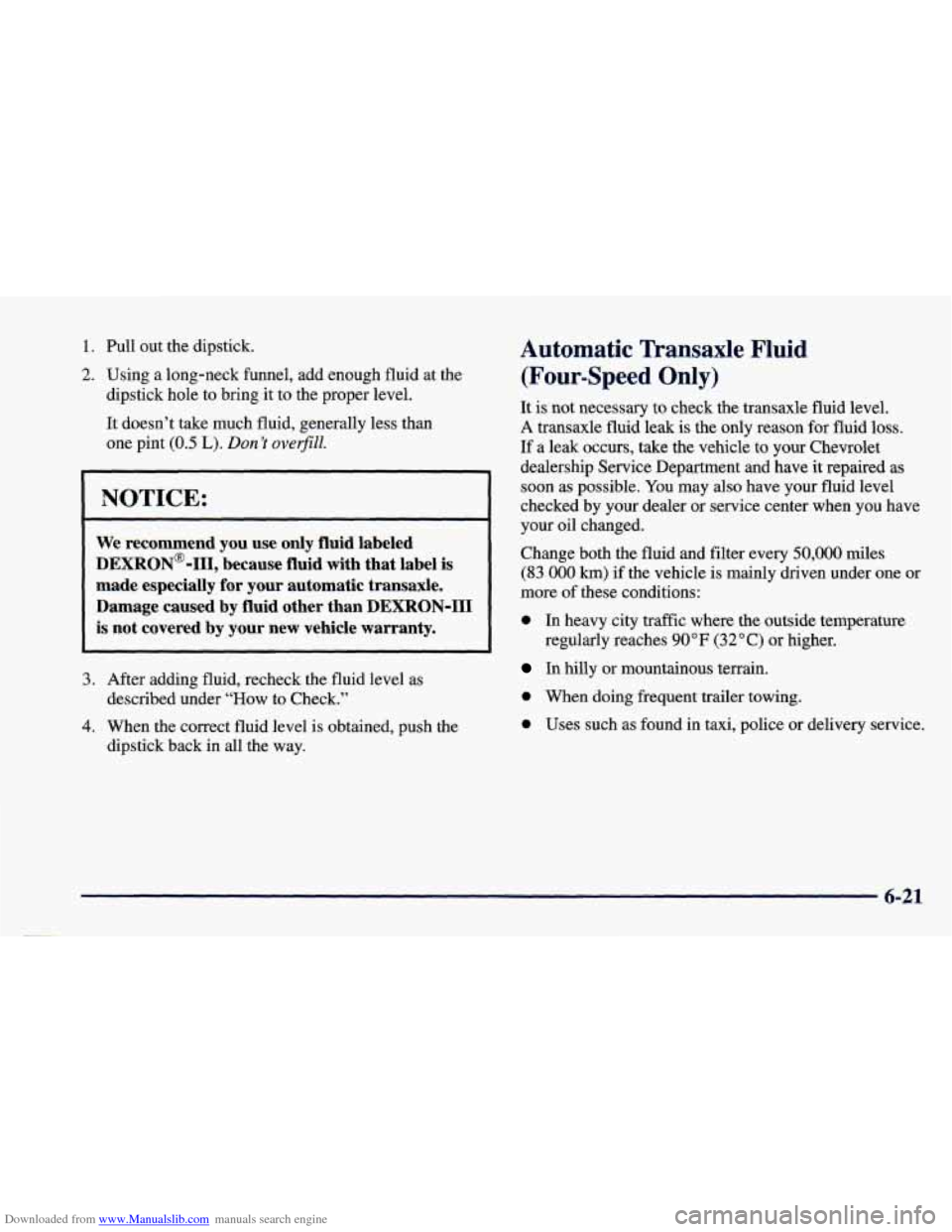
Downloaded from www.Manualslib.com manuals search engine 1. Pull out the dipstick. Automatic Transaxle Fluid
2. Using a long-neck funnel, add enough fluid at the (Four-Speed Only) dipstick hole to bring it to the proper level.
It doesn’t take much fluid, generally less than A transaxle \
fluid leak
is the only reason for fluid loss.
one pint
(0.5 L). Don’t ove$ZZ. If a leak occurs, take the vehicle to your Chevrolet
dealership Service Department and have it repaired as
soon as possible. You may also have your fluid level
checked by your dealer or service center when you have your oil changed.
Change both the fluid and filter every
50,000 miles
(83 000 km) if the vehicle is mainly driven under one or
more of these conditions:
0 In heavy city traffic where the outside temperature
In hilly or mountainous terrain.
It
is not necessary
to check the transaxle fluid level.
NOTICE:
We recommend you use only fluid labeled
DEXRON@-III, because fluid with that label is
made especially for your automatic transaxle.
Damage caused by fluid other than DEXRON-I11
is not covered by your new vehicle warranty. regularly reaches 90 OF (32 O C) or higher.
3. After adding fluid, recheck the fluid level as described under “How to Check.”
0 When doing frequent trailer towing.
4. When the correct fluid level is obtained, push the dipstick back in all the way. 0 Uses such as found in taxi, police or delivery service.
6-21
Page 331 of 400
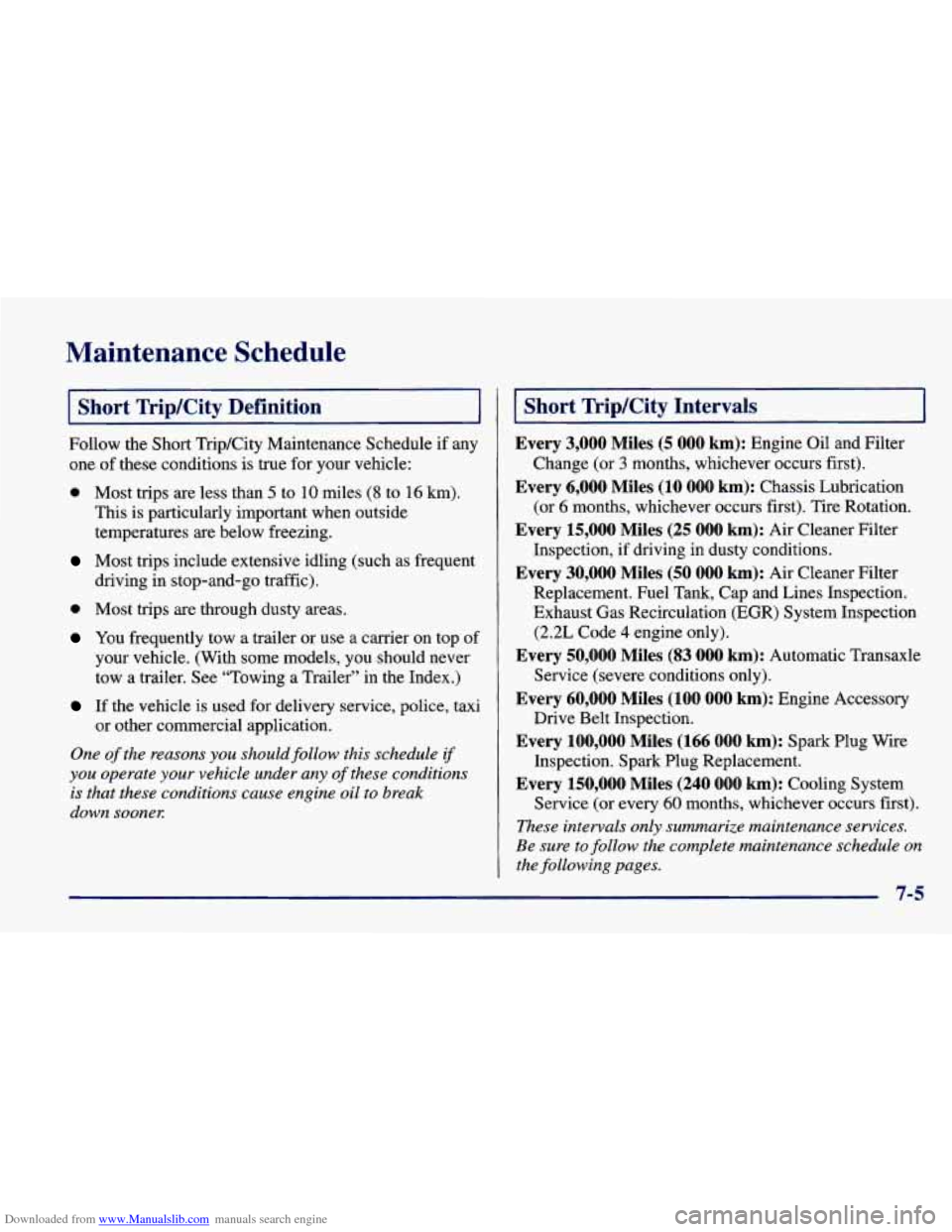
Downloaded from www.Manualslib.com manuals search engine Maintenance Schedule
-G/City Definition
Follow the Short TripKity Maintenance Schedule if any
one of these conditions is true for your vehicle:
0 Most trips are less than 5 to 10 miles (8 to 16 km).
This is particularly important when outside
temperatures are below freezing.
driving in stop-and-go traffic).
Most trips include extensive idling (such as frequent
0 Most trips are through dusty areas.
You frequently tow a trailer or use a carrier on top of
your vehicle. (With some models, you should never
tow a trailer. See “Towing a Trailer” in the Index.)
If the vehicle is used for delivery service, police, taxi
One of the reasons you should follow this schedule if
you operate your vehicle under any of these conditions
is that these conditions cause engine oil to break
down soonex
or other commercial application.
Short Trip/City Intervals
Every 3,000 Miles (5 000 km): Engine Oil and Filter
Every 6,000 Miles (10 000 km): Chassis Lubrication
Every 15,000 Miles (25 000 km): Air Cleaner Filter
Every 30,000 Miles (50 000 km): Air Cleaner Filter
Change (or
3 months, whichever occurs first).
(or
6 months, whichever occurs first). Tire Rotation.
Inspection, if driving in dusty conditions.
Replacement. Fuel Tank, Cap and Lines Inspection. Exhaust Gas Recirculation (EGR) System Inspection (2.2L Code
4 engine only).
Every 50,000 Miles (83 000 km): Automatic Transaxle
Service (severe conditions only).
Every 60,000 Miles (100 000 km): Engine Accessory
Drive Belt Inspection.
Every 100,000 Miles (166 000 km): Spark Plug Wire
Inspection. Spark Plug Replacement.
Every 150,000 Miles (240 000 km): Cooling System
Service (or every
60 months, whichever occurs first).
These intervals only summarize maintenance services.
Be sure to follow the complete maintenance schedule
on
the following pages.
7-5
Page 332 of 400
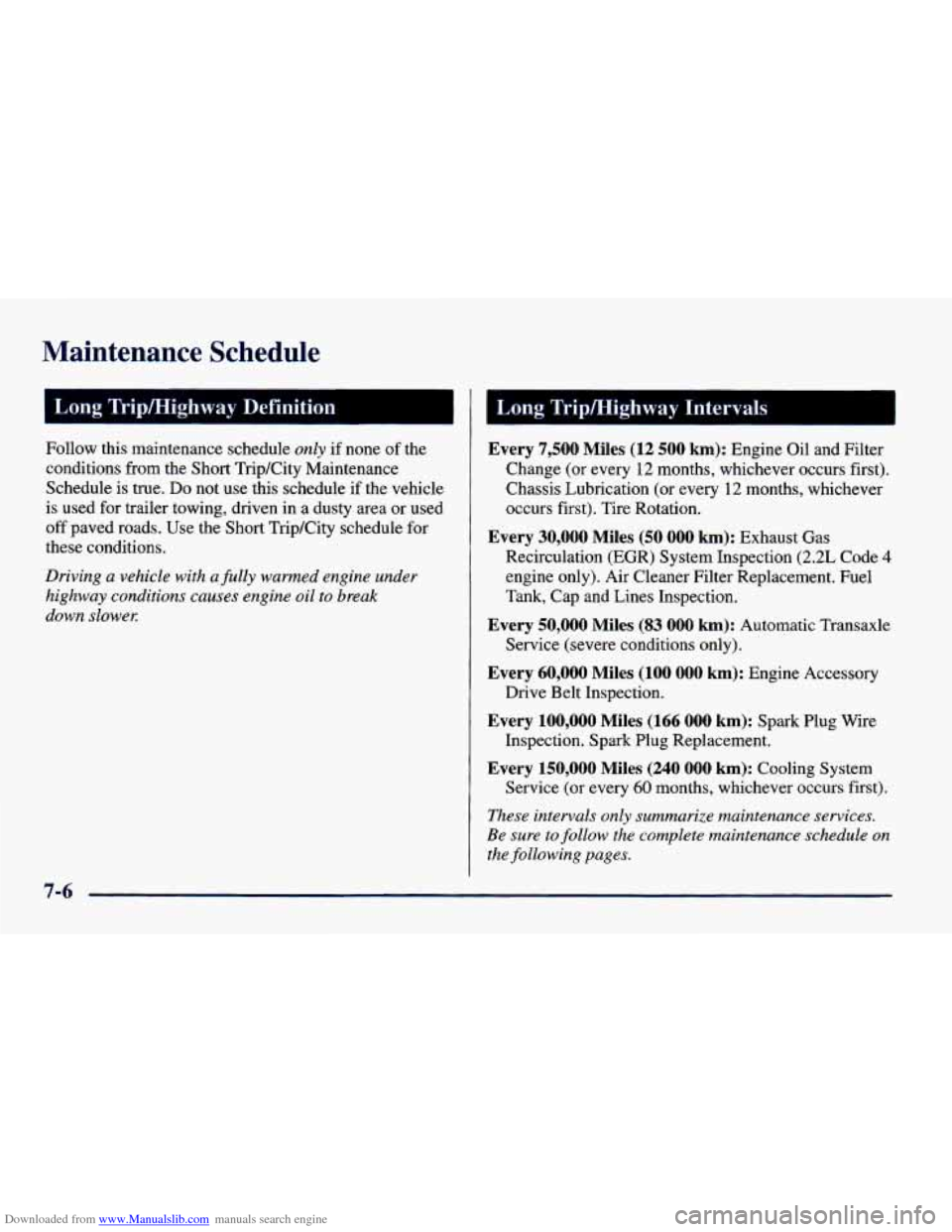
Downloaded from www.Manualslib.com manuals search engine Maintenance Schedule
1 Long Trip/Highway Definition
Follow this maintenance schedule only if none of the
conditions from the Short TripKity Maintenance
Schedule is
true. Do not use this schedule if the vehicle
is used for trailer towing, driven in a dusty area or used
off paved roads. Use the Short TripKity schedule for
these conditions.
Driving a vehicle with a fully warmed engine under
highway conditions causes engine oil to break
down slowel:
7-6
Long Trip/Highway Intervals - -
Every 7,500 Miles (12 500 km): Engine Oil and Filter
Change
(or every 12 months, whichever occurs first).
Chassis Lubrication (or every
12 months, whichever
occurs first). Tire Rotation.
Every 30,000 Miles (50 000 km): Exhaust Gas
Recirculation (EGR) System Inspection
(2.2L Code 4
engine only). Air Cleaner Filter Replacement. Fuel
Tank, Cap and Lines Inspection.
Every 50,000 Miles (83 000 km): Automatic Transaxle
Service (severe conditions only).
Every 60,000 Miles (100 000 km): Engine Accessory
Drive Belt Inspection.
Every 100,000 Miles (166 000 km): Spark Plug Wire
Inspection. Spark Plug Replacement.
Every 150,000 Miles (240 000 km): Cooling System
These intervals only summarize maintenance services.
Be sure to follow the complete maintenance schedule
on
the following pages.
Service (or every 60 months, whichever occurs first).
Page 339 of 400

Downloaded from www.Manualslib.com manuals search engine miTrip/City Maintenance Schedule I
0 Lubricate chassis components (or every 6 months, whichever occurs first).
17 Rotate tires. See “Tire Inspection and Rotation” in the I\
ndex for proper
(See
footnote
#.)
rotation pattern and additional information. (See footnote +.)
(Also see footnote ++.)
50,000 Miles (83 000 km)
0 Change automatic transaxle fluid and filter if the vehicle is mainly driven
under one or more of these conditions:
- In heavy city traffic where the outside temperature regularly r\
eaches
- In hilly or mountainous terrain.
- When doing frequent trailer towing.
- Uses such as found in taxi, police or delivery service.
90°F (32°C) or higher.
If you do not use your vehicle under any of these conditions, the fluid and
filter do not require changing.
Manual transaxle fluid doesn’t require change.
51,000 Miles (85 000 km)
0 Change engine oil and filter (or every 3 months, whichever occurs first).
An Emission Control Service.
DATE I
1
MILEAGE ACTUAL SERVICED BY
I DATE I
MILEAGE ACTUAL I SERVICED BY:
7-13
Page 346 of 400

Downloaded from www.Manualslib.com manuals search engine Short Trip/City Maintenance Schedule
IO0,OOO Miles (I66 000 km)
0 Inspect spark plug wires (except 2.4L Code T engine).
0 Replace spark plugs.
0 Change automatic transaxle fluid and filter if the vehicle is mainly driven
An Emission Control Service.
An Emission Control Service.
under one or more of these conditions:
- In heavy city traffic where the outside temperature regularly r\
eaches 90°F
(32 O C) or higher.
I DATE I
- In hilly or mountainous terrain.
- When doing frequent trailer towing.
- Uses such as found in taxi, police or delivery service.
If you do not use your vehicle under any of these conditions, the fluid and
filter do not require changing.
Manual transaxle fluid doesn’t require change.
150,000 Miles (240 000 km)
0 Drain, flush and refill cooling system (or every 60 months since last service,
whichever occurs first). See “Engine Coolant” in the Index
for what to use.
Inspect hoses. Clean radiator, condenser, pressure cap and neck.\
Pressure test
cooling system and pressure cap.
An Emission Control Service.
7-20